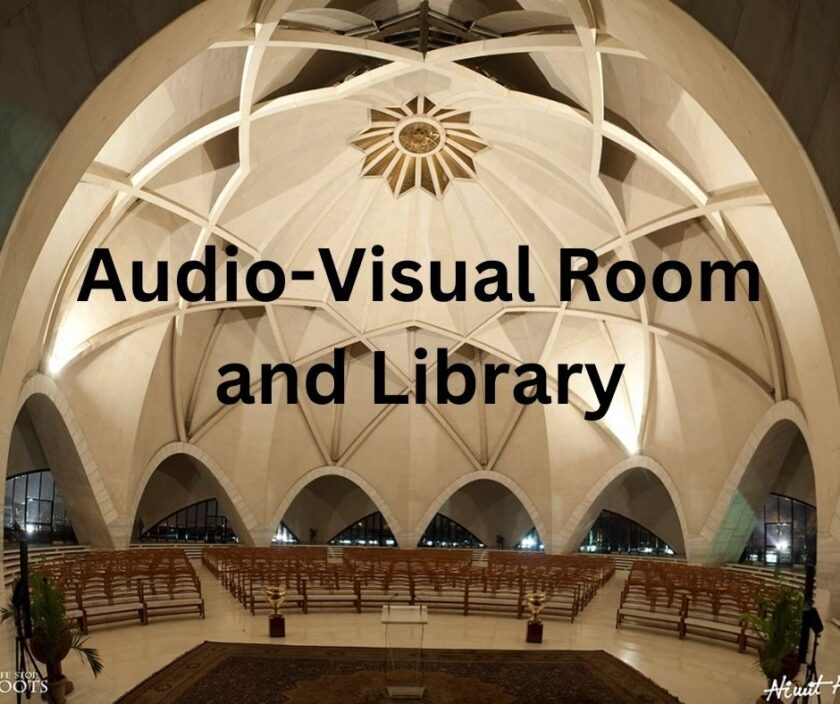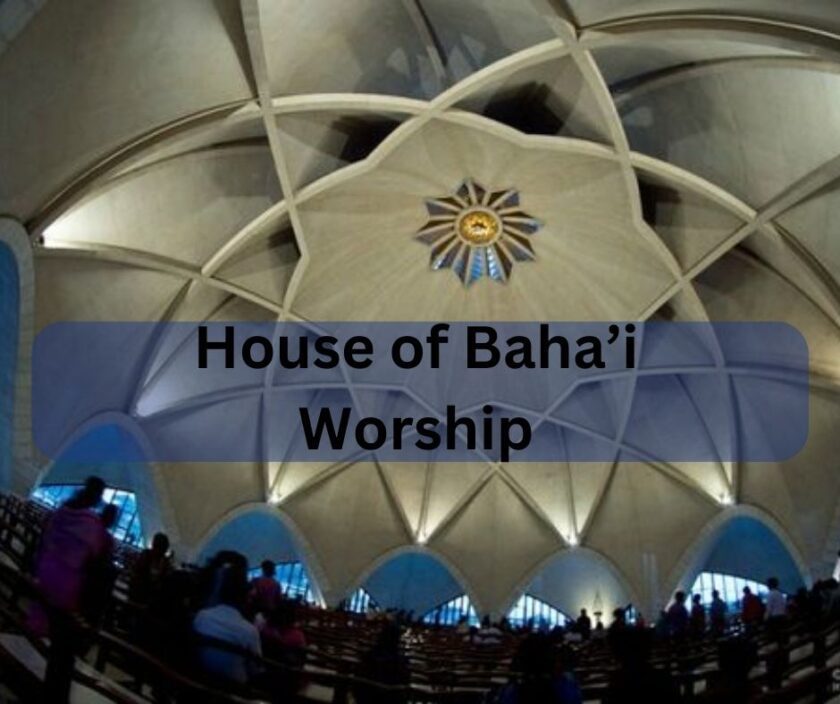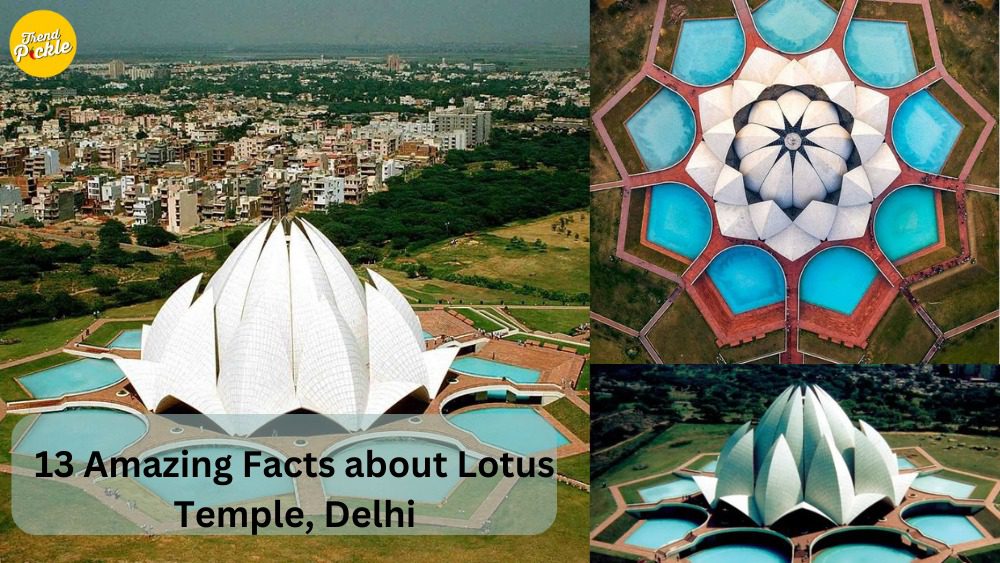The Lotus Temple, situated in New Delhi, India also known as the Bahai House of Worship or Bahai Mashriqul-Adhkar Temple. It is known for its lotus-like shape and stunning modern architecture. This white marble structure is often compared to the Taj Mahal of the 20th century, but it’s much more than just a beautiful building. The temple is made up of 27 separate marble-covered “petals” grouped in sets of three to create nine sides, with nine doors leading to a central hall that stands at just over 34 meters in height and can accommodate around 1,300 people.
In addition, the Lotus Temple is ranked among the 20 wealthiest temples in India, with a total worth of 3000 crore, as reported by Worth Idea. This exceptional architectural wonder has also garnered multiple awards and has been showcased in numerous newspaper and magazine articles.
To know more about these places, today in this article we are going to show you some amazing facts about the lotus temple that not everyone knows. So keep reading these articles till the end.
List of Incredible Facts about Lotus Temple
- The Architectural Marvel
- Universal Worship and Religious Unity
- Absence of Idols
- A Global Icon
- Meaning Worship and Religious Unity
- Elegant Marble from Penteli Mountain
- Solar Powered Temple
- Audio-Visual Room and Library
- Ardishir Rustampur’s Goodness
- Engaging Cultural Activities
- House of Baha’i Worship
- Mastermind Behind the Marvel
- Walkways and Lotus-inspired Pools
1. The Architectural Marvel

The Lotus Temple, also called the Bahá’í House of Worship, is an incredible piece of modern architecture. It was designed by Iranian architect Fariborz Sahba and takes the form of a lotus, a symbol shared by many religions, including Hinduism and Buddhism. The temple’s unique lotus-shaped design has earned it many awards and praise for its beauty and innovative style. It has also been featured in esteemed publications worldwide, like the Encyclopedia Britannica and the Guinness World Records. In addition, it has also been said that the lotus temple beauty has been inspired by postage stamps, books, and even musical compositions.
2. Universal Worship and Religious Unity

The lotus temple is the only place in the world that teaches believing in one god and recognizing that all religions are one. That’s why the temple is open to all people from different religions and backgrounds. It’s a place where anyone can come to worship the creator of the universe, without focusing on a specific god.
3. Absence of Idols

In these temples, you won’t find any statues or idols of deities. People of any faith, from any background, and of any belief are encouraged to come and visit. The temple is open to everyone and the visitors are free to chant or read scriptures from the Bahai faith or any other faith.
4. A Global Icon

This Lotus Temple has become an iconic symbol of Delhi and India. Every year it attracts millions of visitors from all around the world, who just come to see the unique architecture and to experience a peaceful atmosphere. As the lotus temple is surrounded by nine pools, with lotus leaves. This arrangement highlights spiritual purity which adds a calm climate and connects visitors with the lotus theme.
5. Meaning Behind Architecture

The lotus temple is not just a place of worship; it’s also a work of art. As the temple is organised into three layers, with nine petals in each layer. The temple lotus flower design is the most beautiful as it symbolises purity, rebirth, and unity. This combination of art and architecture is the evidence of this remarkable structure. In addition, the temple boasts its beauty with nine entrance designs which lead to a central prayer hall. Thus the design shows that the temple is open to everyone, no matter where they come from.
6. Elegant Marble Structure

The lotus temple’s central hall floor is constructed by using marble from Penteli Mountain in Greece. This high-quality marble enhances its beauty which also reflects the excellence of its construction. The central prayer hall is a remarkable space for seating with a capacity of 2,500 people and a height of 40 meters. Basically, it is designed for worship, meditation, and reflection.
7. Solar Powered Temple

The lotus temple has taken outstanding steps towards sustainable energy practices, as it is one of the leading temples in Delhi to adopt solar energy. By utilising solar power, the lotus temple is actively contributing to the reduction of carbon dioxide in the environment. This eco-friendly step not only reduces the temple’s reliance on conventional energy sources but also sets a positive example for the community and visitors.
8. Audio-Visual Room and Library

The lotus temple is the only place that increases the overall experience by providing an audio-visual room. This place offers an opportunity for people to understand deeper about the Baha’i faith. With the help of multimedia presentations, videos, and interactive displays, helps people to learn and believe in the Baha’i community. As it is the best opportunity to explore the faith’s principles and its message of unity, peace, and oneness.
Along with these, the lotus temple also has a house of a well-stocked library. This library serves as a valuable resource for those who have an interest in religious texts and spiritual literature. So, if you are looking to learn more about the Baha’i faith, the library at the lotus temple is a welcoming haven for all who visit.
9. Ardishír Rustampúr’s goodness

It is said that Ardishir Rustampur was a believer of the Baha’i faith from Hyderabad who showed remarkable selflessness and dedication. Ardishir Rustampur played an important role in building the Lotus temple by donating his savings. His strong commitment and great financial support were necessary in turning the idea of the lotus temple into a reality that still inspires and welcomes people from all around the world.
10. Engaging Cultural Activities

The lotus temple is the only place in Delhi that’s full of spirit centers and a wide arrangement of artistic and educational activities. Because of these, it creates a spirited and overall environmental experience for the people. Inside the temple, you can find different musicals that are relaxing with these heart- warming songs. The lotus temple also has exhibitions that refresh the mind. Hence, all these conditioning which are conducted in the lotus temple continually set up the communication of harmony among its followership. That’s why it isn’t just a place to worship but to celebrate the richness of natural diversity and spiritual oneness.
11. House of Baha’i Worship

In this world, there are a sum total of seven similar remarkable places of Baha’i worshipping. These unique temples can be set up in any corner of the world, as each has its own architectural and spiritual significance. The Baha’i houses of worship are situated in the USA, Sydney, Australia, Panama City, Panama; Apia, Western Samoa; Kampala, Uganda; Frankfurt, Germany; and Wilmet.
12. Mastermind Behind the Marvel

It has been said that the Fariborz Sahba was the genius behind the Lotus temple. He dedicatedly designed the Lotus Temple and handled the project management. To complete the lotus temple he hired almost 800 skilled professionals which included engineers, technicians, artisans, and labourers.
13. Walkways and Lotus-Inspired Pools

The most beautiful lotus temple is surrounded by attractive walkways. The walkways are beautifully curved with lovely bridges and staircases. These pathways circle the nine pools which are specially designed with lotus flower’s floating leaves. This combination of arts creates a beautiful overall experience of visiting this most famous and unique place of worship in Delhi.
Conclusion
Hence, the Bahai Lotus Temple in Delhi is one of the most beautiful religious buildings that you should definitely visit. The best part is, it’s open to everyone, no matter what your religion. In fact, it is a place where people from around the world come for peace, meditation, prayer, and study. So, when you’re in Delhi, don’t miss this incredible temple!
FAQ
What is the Lotus Temple, and where is it located?
The Lotus Temple, also known as the Bahai House of Worship for Baha’i Mashriqul-Adhkar Temple, is situated in New Delhi, India. It is a renowned architectural marvel and a place of worship.
How is the Lotus Temple’s architecture described?
The Lotus Temple features a lotus-like shape and modern architecture, often compared to the Taj Mahal of the 20th century. It comprises 27 separate marble-covered “petals” grouped into sets of three to create nine sides. These nine sides lead to a central hall that stands at just over 34 meters in height and can accommodate approximately 1,300 people.
Is the Lotus Temple among the wealthiest temples in India?
Yes, the Lotus Temple is ranked among the 20 wealthiest temples in India, with a total worth of 3000 crore, as reported by Worth Idea.
Why is the Lotus Temple considered an architectural marvel?
The Lotus Temple’s unique lotus-shaped design, created by Iranian architect Fariborz Sahba, has earned it numerous awards and recognition for its beauty and innovative style. It has also been featured in prestigious publications, including the Encyclopedia Britannica and the Guinness World Records.
Is the Lotus Temple open to people of all religions?
Yes, the Lotus Temple is open to people of all religions and backgrounds. It is a place that promotes universal worship and religious unity.
Are there any idols or religious statues inside the Lotus Temple?
No, the Lotus Temple does not have any statues or idols of deities. People of any faith, background, or belief are encouraged to visit.
Why is the Lotus Temple often considered a global icon?
The Lotus Temple has become an iconic symbol of Delhi and India, attracting millions of visitors from around the world. Its unique architecture and peaceful atmosphere contribute to its global appeal.
What is the significance of the Lotus Temple’s design?
The Lotus Temple’s design symbolises purity, rebirth, and unity. It is organised into three layers with nine petals in each layer, signifying inclusivity and openness.
How is the Lotus Temple powered?
The Lotus Temple is a pioneer in using solar power among temples in Delhi. This eco-friendly approach helps reduce its carbon footprint and serves as a model for sustainable energy practices.
What educational resources are available at the Lotus Temple?
The Lotus Temple provides an audio-visual room for visitors to learn about the Baha’i faith through multimedia presentations and interactive displays. Additionally, there is a well-stocked library with religious texts and spiritual literature for those interested in further exploration.

